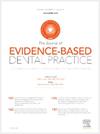INTEGRATION OF DENTAL PATIENT-REPORTED OUTCOMES (dPROs) IN TELEDENTISTRY TO ENHANCE PATIENT-CENTERED CARE: A SCOPING REVIEW
IF 4
4区 医学
Q1 DENTISTRY, ORAL SURGERY & MEDICINE
引用次数: 0
Abstract
Introduction
Teledentistry offers an opportunity to improve Patient-Centered Care (PCC) for dental patients. Evaluation of PCC in conventional and teledentistry requires the use of Dental Patient-Reported Outcome Measures (dPROMs). However, there is limited literature on the integration of dPROMs in teledentistry, and a need arises for the synthesis of existing knowledge, comprehending it and identifying the gaps. Hence, conducting a scoping review would systematically map out the key themes, provide insights into the trends and highlight knowledge gaps in the currently published literature.
Methods
Google Scholar, Scopus, and Web of Science databases were searched using a combination of keywords such as “Teledentistry,” “dental patient-reported outcome measures,” and “dPROMs.” Using established eligibility criteria, suitable records were exported and organized on an Excel sheet. Original research and review articles in English where dPROMs or its dimensions were used after a teledentistry session were included. The Preferred Reporting Items for Systematic Reviews and Meta-Analyses extension for scoping review (PRISMA-ScR) criteria was followed to report the results.
Results
Out of the 28 reviewed studies, majority were cross-sectional and were largely conducted in the UK, the USA, India, and Indonesia. Studies predominantly had adult population and female participants. Most studies highlighted dPROMs dimensions such as patient satisfaction, communication, and travel convenience, suggesting that dPROMs in teledentistry may enhance PCC.
Conclusion
Distinction between the indicators of PCC, like patient satisfaction and patient experience, is necessary. Future studies should concentrate on longitudinal studies across various demographic groups with standardized measurement and equal gender representation.
整合牙科病人报告的结果(dPROs)在远程牙科以加强病人为中心的护理:一项范围回顾
远程牙科为牙科患者提供了一个改善以患者为中心的护理(PCC)的机会。评估PCC在传统和远程牙科需要使用牙科患者报告的结果测量(dPROMs)。然而,关于dprom在远程医学中的整合的文献有限,因此需要综合现有知识,理解它并确定差距。因此,进行范围审查将系统地绘制出关键主题,提供对趋势的见解,并突出当前已发表文献中的知识差距。方法使用“远程牙科”、“牙科患者报告的结果测量”和“dprom”等关键词组合搜索google Scholar、Scopus和Web of Science数据库。使用已建立的资格标准,导出合适的记录并将其组织到Excel表格中。包括在远程医学会议后使用dprom或其维度的英文原始研究和评论文章。按照系统评价和荟萃分析扩展范围评价的首选报告项目(PRISMA-ScR)标准报告结果。结果在回顾的28项研究中,大多数是横断面研究,主要在英国、美国、印度和印度尼西亚进行。研究对象主要是成年人和女性。大多数研究强调了dPROMs的维度,如患者满意度、沟通和旅行便利,表明远程牙科中的dPROMs可能会提高PCC。结论对PCC的患者满意度和患者体验等指标进行区分是必要的。今后的研究应集中在各种人口群体的纵向研究,采用标准化的测量方法和平等的性别代表性。
本文章由计算机程序翻译,如有差异,请以英文原文为准。
求助全文
约1分钟内获得全文
求助全文
来源期刊

Journal of Evidence-Based Dental Practice
DENTISTRY, ORAL SURGERY & MEDICINE-
CiteScore
6.00
自引率
16.70%
发文量
105
审稿时长
28 days
期刊介绍:
The Journal of Evidence-Based Dental Practice presents timely original articles, as well as reviews of articles on the results and outcomes of clinical procedures and treatment. The Journal advocates the use or rejection of a procedure based on solid, clinical evidence found in literature. The Journal''s dynamic operating principles are explicitness in process and objectives, publication of the highest-quality reviews and original articles, and an emphasis on objectivity.
 求助内容:
求助内容: 应助结果提醒方式:
应助结果提醒方式:


